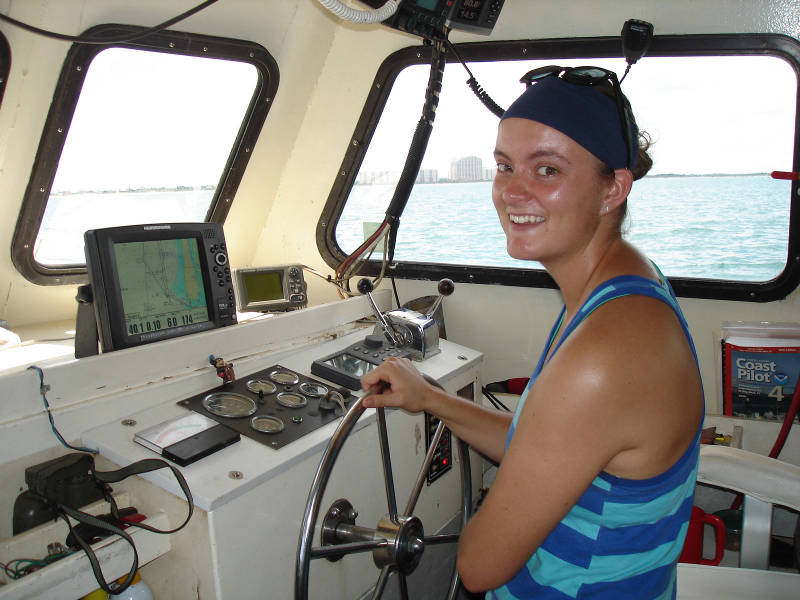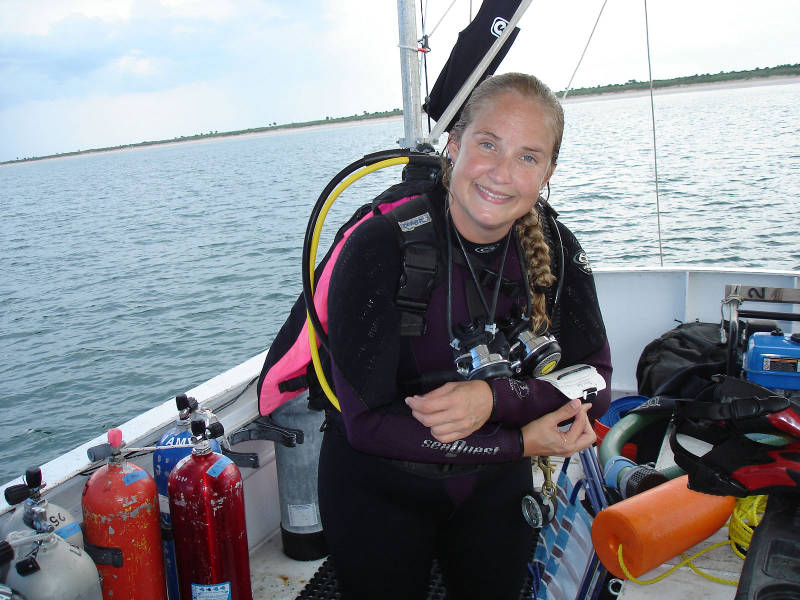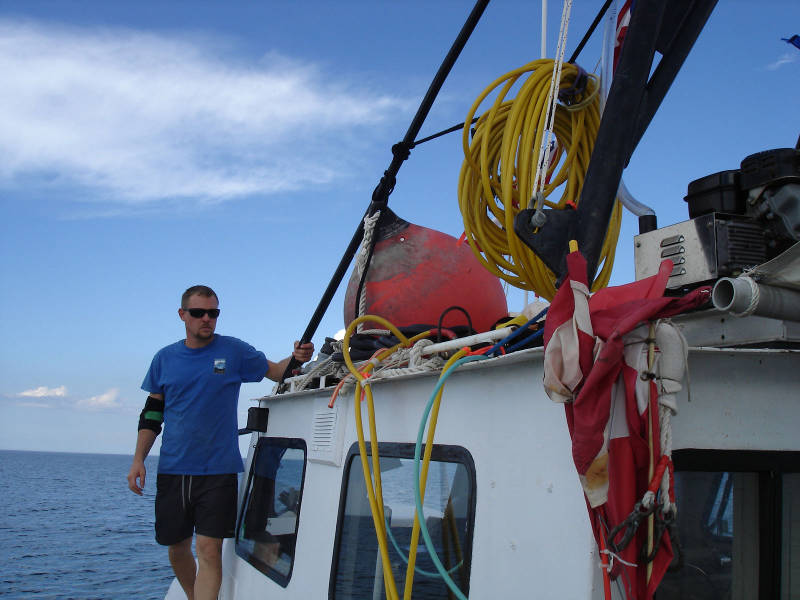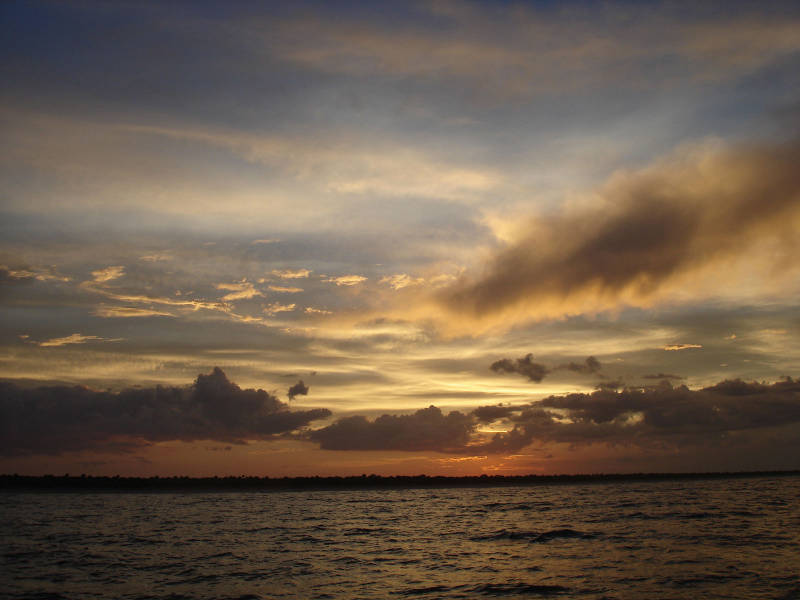
By Starr Cox, Archaeological Conservator - Lighthouse Archaeological Maritime Program
August 13, 2014

Olivia McDaniel driving the boat from Ponce Inlet south past New Smyrna Beach to the survey area. Image courtesy of Image courtesy of the Search for the Lost French Fleet of 1565 Expedition, NOAA-OER/St. Augustine Lighthouse & Museum. Download larger version (jpg, 310 KB).
Of the three individual cruises scheduled for this project, only this final cruise has the advantage of “women archaeologists.” We (the entire LAMP team) got off to a slow start this morning, inspecting an oil leak in the engine room to ensure there was no serious mechanical problem, refueling the vessel and taking on ice, cruising from Ponce Inlet to the current target, and setting the bow and stern anchors to secure the boat over the dive target. When it was finally time to dive, Olivia McDaniel and myself were first up!

Starr Cox preparing for her first dive. The mission: to probe a series of holes along an east-west line on the bottom, in hopes of finding the source of the magnetism at Target E3T. Image courtesy of Image courtesy of the Search for the Lost French Fleet of 1565 Expedition, NOAA-OER/St. Augustine Lighthouse & Museum. Download larger version (jpg, 387 KB).
Our goal was to finish probing Target E3T, which was started the previous day by the Cruise 2 team. The first team had completed a transect or linear series of probes, spaced one meter apart, running north and south from the central point of the magnetic anomaly.

Brendan Burke, having deployed the hookah hoses (yellow) which feed the divers air, keeps an eye on the divers’ bubbles for the duration of the dive. Image courtesy of Image courtesy of the Search for the Lost French Fleet of 1565 Expedition, NOAA-OER/St. Augustine Lighthouse & Museum. Download larger version (jpg, 273 KB).
So it was our job to probe the east/west line. Neither of us had probed before, and we were both eager to learn. Also, we had heard that one team member from the previous cruise, who shall remain unnamed, had suggested that handling the probe is such a difficult and strenuous task that it might be better to use a man-woman team instead of two women working together. So we were also eager to prove that we could do anything a buddy pair of boys could do!
After setting up the east/west base line, which entails stretching out a 20-meter long tape measure centered on the drop buoy and securing the ends with fiberglass rods, we began probing from west to east. It is a difficult task, manhandling the 10-foot long steel probe into a vertical position and then hammering it repeatedly downward through sand and layers of shell. But nothing that we couldn’t handle!
Our very first attempt met with resistance, but since we had not done this task before, we were not sure if we had found something or if we were just fighting the layers of sediment. We chose to continue on and see what other probes encountered. The next three probes sank into the sediment like a hot knife in butter. Our fifth probe met resistance again, but like the first one, it wasn’t a hard return and we were still uncertain. However, our seventh probe had a definite hard return, and only two feet down!
We tried to uncover a portion of the item to get a better grasp of what we found. While the hydraulic probe can be used to jet sand away, it really isn’t designed to excavate in the same way as a dredge, and it proved difficult to open up a large enough area to reach down and see the object. We were able to reach down and feel a large item, and it was definitely concreted over, and therefore made of iron!
Finding a concretion—an iron object covered in encrustation—is a very good indication that we have a shipwreck! At this point in our dive, we decided to resurface and discuss the next step with the rest of the team.

We are treated to a beautiful sunset as we impatiently await the calm seas that will come with dawn, so that we can dive on our possible shipwreck! Image courtesy of Image courtesy of the Search for the Lost French Fleet of 1565 Expedition, NOAA-OER/St. Augustine Lighthouse & Museum. Download larger version (jpg, 227 KB).
As soon as we yelled out across the water that we had found a concretion, the rest of the crew burst into action. They helped us pull the probe back onto the boat and helped us get back aboard and everyone was chattering before we even got our dive gear off. A concretion is exactly the kind of object we would expect to find on a historic shipwreck site, especially considering that we also had two other positive returns from our probing along this transect.
We had even made arrangements with a local doctor in New Smyrna Beach to allow us the use of his x-ray machine in order to x-ray any concretions we might find in order to identify the artifacts that might be preserved within. The excitement in everyone’s voices was palpable.
We all agreed the next step is to deploy the dredge so we can excavate around the unknown concretion in a controlled manner. This will allow us to carefully expose the object, in order to get a grasp of what exactly it is that we have discovered. In fact, the boys were ready to jump in the water immediately to investigate further, despite the late hour, but we decide against that as we notice the seas are picking up noticeably and we decide it is too rough to stay on a two-point anchor system any longer.
So, we reluctantly cast off our buoyed stern anchor and enjoy the sunset as the boat slowly drifts from our site, known for now as Target E3T. In the meanwhile, we can’t contain our excitement, and our mystery concretion down there on the bottom of the ocean is the constant topic of conversation!
Will it prove to be a 1565 French shipwreck? We will have to wait until tomorrow to make that discovery.